Q&A – Ask Neil: June 20, 2024
(Please read these instructions carefully.)
Before you post your question, please look at recent issues to see if someone else has already asked it. You might find your answer there.
How to submit your question…
(Note: You may need to allow a pop-up window to come up in order to get the link for sending your photo(s). If you have already submitted your question and didn’t see the pop-up window, please click here.)
• Click the link provided below to post your question. After you submit your question, a new window will pop up giving you the address to which you can e-mail a SHARP, HIGH-RESOLUTION PHOTO to accompany your question. Please DO NOT SEND THUMBNAIL PHOTOS in case I need to zoom in to see things.
• Click here to post your question.
• Please ONLY POST YOUR QUESTION ONE TIME. We can only accept a set number of questions each week, and when we get duplicates it costs other people their chances.
• One question per reader, please.
• Please use this only for posting questions – not for standard emails.
• Watch for your answer in the following week’s e-gardens.
• I choose those of greatest general interest. For example, plant IDs seldom make the cut.
• I must have your first name or initials.
• I must have your city or county. (Texas is a very large state.)
QUESTION 1
HOW DEEP CAN I BUILD A RAISED BED BENEATH A LARGE RED OAK?
Question: How deep can I build a raised bed beneath a large red oak without hurting the tree? I can no longer grow St. Augustine there and I know I could damage the tree if I got too much soil over its roots. Veronica D., Denison.
Answer: You don’t have to go “up” with the new bed. In the absence of a photo, I’m assuming you’re not talking about involving the entire drip line of the tree with the new bed, but just the interior portion closest to the trunk where the shade is the heaviest. If you mark where the largest roots and sprinkler heads are, you can carefully rototill 4 or 5 inches into the soil between the major roots. Then you can work several inches of organic matter into the soil and rototill again. That will give you a really good planting mix. Organic matter does not count against you as you use it beneath trees – it won’t hurt their roots. All of this will give you the ability to plant sprawling, spreading plants that will conceal the large surface roots as they expand (and they will!). Remember that organic matter decays, so the surface level will go back to where the soil line is now. Don’t put some tall type of bed edging around all of this. Just let the soil come down to grade level so it can blend back into the earth visually. You don’t want to draw a lot of attention to the trunk of the tree.
QUESTION 2
WHAT IS KILLING MY PHOTINIA RAPIDLY?
Question: My photinia is dying rapidly. It’s one of three in a row. Is this Entomosporium? It looked fine a few weeks ago. Charity H., Denison.
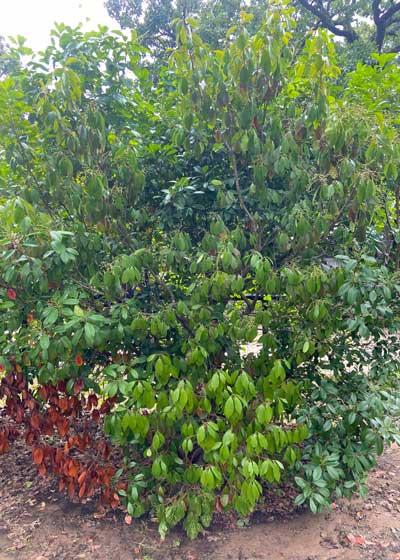
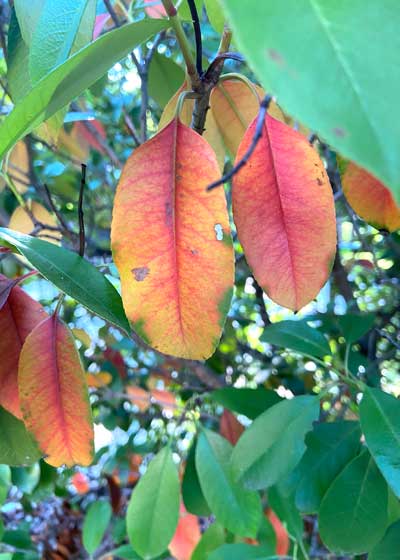
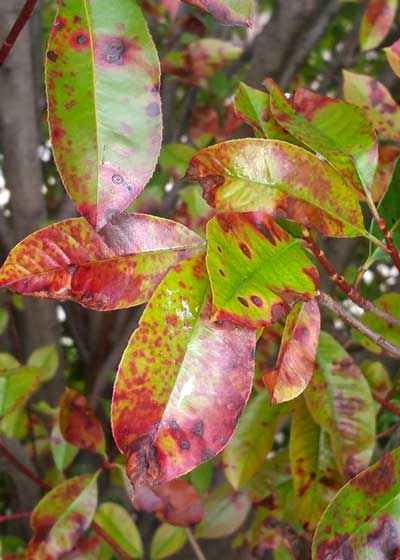
Answer: If you look closely at the photo of the entire plant you’ll notice that it is wilted top to bottom. Entomosporium doesn’t do that. And you’ll see an absence of any of the characteristic maroon speckles and white leaves for which Entomosporium has become known.
My bet would be that this plant has been hit by the soil-borne cotton root rot fungus. The only thing that puzzles me is that in Grayson County, Denison is generally in the red acidic soils (where cotton root rot is much less common), while Sherman has the alkaline black clay (where cotton root rot is quite common). I live and garden 40 miles south of you in Collin County, and those of us along US-75 and I-35 are way too familiar with this look with photinias and many other plant species. If the plant continues to go downhill over the next 2-3 weeks, that’s what the problem is. You will need to replace it with a type of shrub that is immune to that disease. Hollies are the best choice.
QUESTION 3
WHAT WILL KILL THIS WILD GROUND COVER?
Question: What will kill this wild ground cover that has suddenly started taking over? It has small blue flowers when it blooms. How can I get rid of it? Danny S., Arlington.
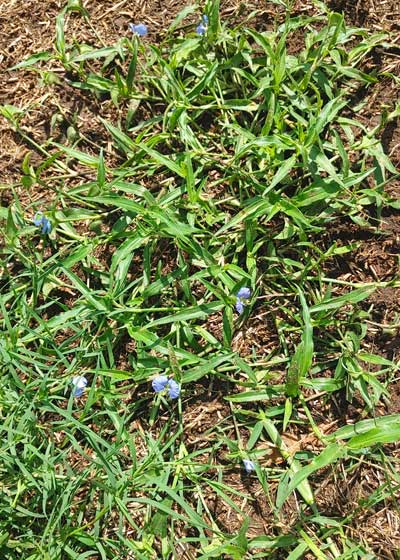
Answer: Congratulations! You have dayflower, one of the more difficult weeds to eliminate. That’s partly because of the way it grows and the speed with which it spreads, also because its leaves are rather waxy and shed herbicide sprays. Dayflowers are sisters to our ornamental wandering Jews. You’ll need to use a broaleafed weedkiller applied repeatedly to the leaves and runners. You may even need to resort to applying it with a foam rubber paintbrush. Here is a good writeup from a national information base of Extension specialists.
QUESTION 4
WHAT WOULD BE A GOOD REPLACEMENT FOR SKY PENCIL HOLLIES THAT HAVE DIED IN MY ALKALINE SOIL?
Question: My Sky Pencil hollies planted one year ago are now toast. I have alkaline soil, so the mistake was mine. I kept them watered with 7 to 10 gallons of water every 2 to 3 days. I used an acid-forming fertilizer and an iron additive, but to no avail. What would a good replacement be? Richard R., San Antonio.
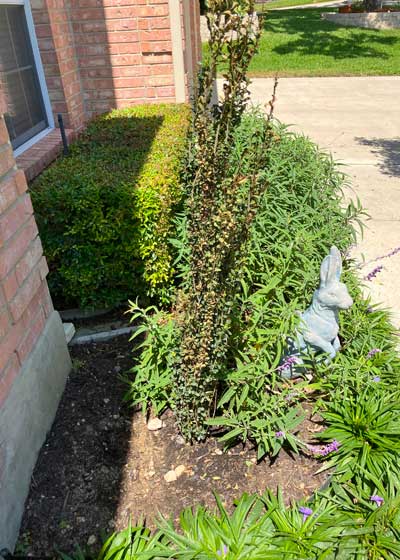
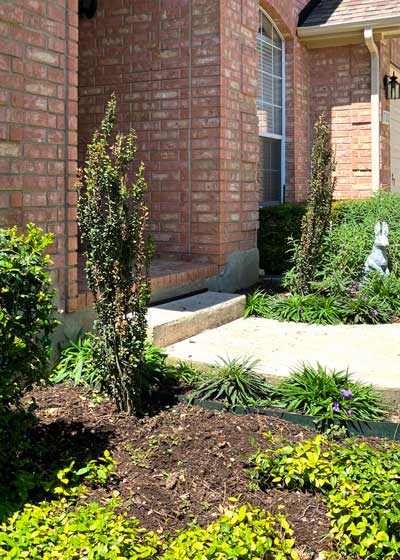
Answer: That mistake was not yours. If you have alkaline soil, and if they were sold to you by a nursery near your house, that nursery should not have offered them for sale. Or at least they should have given you stern warnings that you were likely to lose them. Sky Pencil is a selection of Ilex crenata, Japanese holly. They are notoriously ill-suited to alkaline soils. If you need a columnar, small-leafed holly, Scarlet’s Peak yaupon would be your best bet. However, it’s hard to find. I’d really suggest you go with Oakland holly. It’s a bit wider and its leaves are larger, but it would be a lot easier.
QUESTION 5
WHAT IS DAMAGING THE LEAVES OF MY STRAWBERRY PLANT?
Question: I planted a strawberry plant in early May. It gets full sun all day. Now it looks like something is eating the leaves, and the leaves have brown speckles. Do I need Sevin or Bt, or perhaps something else? JWC, Dallas.

Answer: Strawberries are challenging at best in most of Texas, Dallas certainly included. You would plant strawberry plants in February, pinch off the flowers the first year, and harvest from them the second spring. For readers in South Texas they are planted in the fall and harvested in the spring. Some growers produce their crops in hoop greenhouses, again planting in fall for a spring harvest.
You’re probably sensing that summer is the big enemy to strawberry production in Texas. They do need full sun, but temperatures in the 80s would suit them much better than what we have to provide. Your plant looks like it’s struggling from heat and sunscald. There might be a little of a fungal leaf spot, but your plant’s problem is more likely weather-related. Much of Texas has had hail. That certainly would have damaged the plant. And strawberries demand the best possible bed preparation. I can’t tell what you did to prepare the soil for this plant, but you want to work several inches of organic matter into the ground before planting. Probably the best thing you could do for it now would be to dig and replant it into a large pot in a shady location over the summer, then plant it into a better spot this fall.
QUESTION 6
WHY ARE TWO AREAS OF MY BERMUDA BROWN EVERY YEAR?
Question: Every year two nearby areas of my front yard’s bermudagrass turn brown. The grass thins out as it first gets hot. It bounces back briefly in July, but then the same thing happens later in the summer. The grass surrounding that area is healthy. Water does not solve the problem, nor do insecticides or fungicides. Any suggestions? Matt R., Frisco

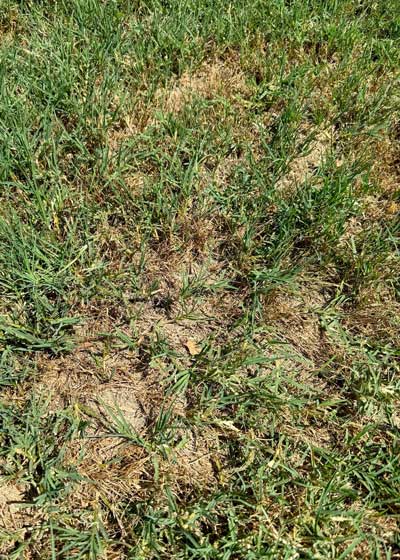
Answer: Since you have tried insecticides and fungicides, I’m going to rule those pests out. Looking at your close-up photo, it really looks like you might have a thatch accumulation. To explain, thatch is undecomposed organic matter (i.e., grass clippings) that accumulates on top of the soil and beneath the grass runners. Over time the clippings can pack together to form an impenetrable layer that sheds water and nutrition (as with thatch roofs). Lawngrasses that are trying to survive where there is thatch end up with shortened roots growing atop the thatch layer – very few roots penetrating the thatch and getting down into the actual soil. Water and nutrients, because they are being shed from the surface, are lacking and the grass struggles once it turns hot and dry.
The way to determine if you do indeed have an accumulation of thatch is to use a square-bladed shovel called a tile spade or nursery spade. Dig a small piece of sod out and pull it apart. Do you see that thick, corky layer of packed organic matter, mainly grass clippings?
If you do find thatch is the issue, rent a core aerator that will pull actual plugs out of the soil. Flag any sprinkler heads, then run the aerator back and forth over the lawn. The holes it will leave behind will allow air, water, and nutrients to get through and into the soil. You should see a noticeable difference in the performance of your lawn.
Plan B: It’s also possible that you have debris buried in those spots from the time the house was built. Or there could have been a pile of sand or gravel that resulted in poorer topsoil in which the grass could grow. You can probe around or take samples for quick analysis. You might have some digging and replacing of soil ahead of you.
QUESTION 7
WHY AM I SEEING SO MUCH BROWN IN MY EMERALD ZOYSIA?
Question: Why am I seeing so much brown in my Emerald zoysia? Is this a fungal problem? I mow it twice weekly at 2 inches. As a side note, I also have St. Augustine which I have mowed at 2 inches twice weekly for more than 10 years without ever having any fungal problem. It looks great. Keith F., Mansfield.


Answer: The close-up photo shows grass that is dry – blades rolled. It also shows a lot of brown blades, just as you said.
Yours was the first question to come in this week, so by all rights it should have been marked as Question 1. However, I had already written my reply to the question just above (Question 6), so I moved you down here. This really does look like thatch once again. Zoysia, like bermuda, is known to produce harmful thatch layers. (St. Augustine, not so much.) You are doing the right thing by mowing frequently. That makes me wonder if you are mulching your clippings back onto the lawn. If so, that may be how the organic matter is getting its start.
If you check your lawn and find that you do have thatch, use a rented core aerator to cut through it. Catch your clippings for a few months. Be sure that you are using a high-quality lawn food that has 30 to 40 percent of its nitrogen in slow-release form. Fertilizers with fast-release nitrogen are much more likely to lead to accumulations of thatch.
I think I see more browning right up against the stone ledge. That might be due to even more clippings accumulating in that area.
Oh, gosh I hope I’ve hit this nail on the head for you!
